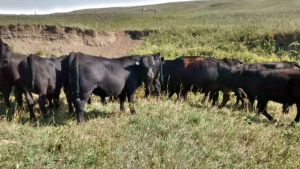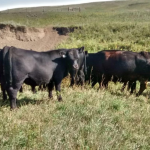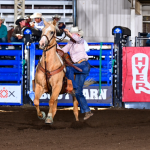VC Kelly Ranch: 128 year legacy
for Tri-State Livestock News

The freighter, Albert Drew, after picking the sites, turned the building of them over to his married daughters. Albert and his wife, Mary lived in Spearfish, SD. One of their daughters was Sarah Alice “Allie” Drew. After she married Jack Kelly in 1895, they settled on the Rabbit Creek place, and had cottonwood timber, live water, flowing wells and lush grass. It’s about 30 miles northwest of where Faith, SD, is now.
The first improvements were of log and sod, and the ranch ran cattle, sheep and horses on the open prairie. The closest place to get supplies was Belle Fourche, SD, and they made those trips for supplies in the spring and fall. Their mail first was received at Bixby, on the Moreau River to the southwest.
In those early days, the cattle were shipped from Belle Fourche or from Everetts, SD on the Missouri River (now under Lake Oahe), where they crossed on pontoon bridges to reach the railroad. They also loaded horses on to railcars and shipped them to Chicago to be sold as well.
Three sons, Wayne, Zeal and Merle, were born to Jack and Allie. Zeal died from infantile paralysis (polio) at age 11. Wayne and Merle, born in 1894 and 1896, respectively, grew to manhood on the ranch, becoming top hands, great ropers, and horsemen.
nt Located on a bench above Rabbit Creek, the Kelly Ranch headquarters has watched many seasons pass since being established in 1894. A freighter who hauled supplies from Bismarck, ND, to the Black Hills, passed across the prairie and, with an eye for establishing ranches in the area, chose sites for several.
The brothers produced rodeos in the early part of the 1900s, including the Black Hills Roundup. They were both Roman riders, besides being ropers and bronc riders.
Wayne, the wilder of the two boys, was full of life and got into trouble due to his pranks and cowboy shenanigans. In 1928, Wayne was shot and killed by the Perkins County Sheriff, Floyd Short.
Wayne left behind his wife Julia, and one daughter, Elaine. They remained on the ranch until Elaine was nearly grown then moved to Wyoming and Julia remarried.
Merle, having lost his brother and best friend, quit producing rodeos and concentrated on ranching along with his folks, Jack and Allie. They raised cattle, sheep and horses. The Remount program contributed to the quality of the horses on the ranch, and the Kelly’s were always well mounted. They sold horses to the Remount until around 1949.
Merle married Lucille Little in 1916, and they had one son, Lloyd in 1917. Lloyd grew up on the Kelly Ranch, and married Hilma Voss with whom he had four daughters.
Merle later married Cora Grout (born in 1909) in 1928; they continued to ranch on Rabbit Creek. Cora, a school teacher, would ride the big remount broncs to school each day. Cora was very petite and often had to get the horses off into a deep snowdrift to get on, as they were just green broke and pretty tall. She was a good hand and worked alongside Merle on the ranch when she wasn’t teaching school.
Merle and Cora’s only child, a daughter Patty, was born in 1943. She grew up alongside Lloyd’s daughters, Colleen (Samuelson), Darlene, Kristie (Foster) and Marlene (Gustafson), who being close in age, were more like sisters to her.
Patty, also a school teacher, married Gene Escott in 1964, and they ranched north of Faith, SD. They had three daughters and a son. Daughter Gnene (Clint) Fordyce, has two kids, is a teacher and ranches north of Faith. Gnelle (Scott) Dauwen, has two kids, and is a teacher at Cambridge, NE. Gzelle “Buffy” (Kevin) Groves has four kids, is a coach at Faith, and ranches north of Faith. Son Kelly has three kids and ranches north of Faith.
Merle and Cora ran Hereford cattle all the years they ranched. The steers were run until they were mature, with the last bunch of 3-year-old steers being sold off the ranch in 1981 due to drought.
In 1944 after being gravely injured in a wreck while crossing the street in Faith, Merle slowly recovered from multiple broken bones. Several years later, his mowing tractor tipped off the bank and fell into the creek, with a section from the mower lodging in his head. Cora pulled the section from his head to get him out of the creek, and he had to recover once again.
It was always suspected that these two incidents led to the growth of a tumor near his optic nerve. In about 1972, Merle lost his eyesight when he had surgery to remove the tumor. Though blind, he still managed the ranch alongside Cora, and even after years of not being able to see the land or ride across it, he knew every draw, creek crossing, and detail of the ranch until he died.
In 1985, Merle and Cora were still on the ranch when Cora had a massive stroke and was taken to the hospital. Not daring to leave Merle alone at the ranch, he was taken along. Cora passed away at the hospital, and Merle died within hours of her death.
Patty Kelly, who took over the ranch when her folks passed away so suddenly, has made some changes to the ranch and the headquarters. Old buildings and corrals have been replaced with new. Sheep were brought back and the cowherd was changed to black.
Kelly is justifiably proud of the new 2,000 square foot sheep shed. It’s insulated, has exhaust fans, and can accommodate 750 jug pens, the drop bunch, and bull pens for pairs. She has also added lots of three-sided sheds for shelter. New windbreak fencing has been added as needed as well.
The love of good horses with speed was passed along to Patty. She started raising speed bred horses in 1964 and continued through 2012, when she dispersed the mares. Her stallion was sold in 2009. The ranch retained a group of young horses for its own use, all with speed blood, and the characteristics to hold up to the work on the ranch.
In 2004, wanting to build the sheep up, the ranch’s 1,800 mother cows were dispersed. The ranch now runs 3,000 head of ewes.
Patty Kelly has three full-time employees who help her manage the sheep. Running that many sheep requires intensive range management. “We are in the Conservation Stewardship Program and have cross-fenced the summer pastures and herd the sheep to utilize the pastures better,” Kelly said. “The men live in campers out in the pastures with the sheep and know everything that goes on with them.”
These valued employees forced Patty to learn to speak Spanish, however. They are Peruvian and are here on three-year work visas. After three years, they have to go back for four months. Luis, who is married with a family, has been with Kelly for eight years. The other two Roli and David are both single and Roli has been working for Kelly for about four years and David just left for his first four months in Peru after working three years at the Kelly Ranch. He will return in January.
“The guys all speak some English, but I found that my meaning is often lost in translation. So, I learned to speak Spanish so they understood what I meant,” Kelly chuckled.
Kelly was instrumental in bringing the Western Range Association to South Dakota, which allows members to get more help when needed. Her seasonal employees generally come through the organization and are Peruvian as well.
Where there are sheep, there are always predators. “The coyotes were a huge problem before I started raising the Akbash guard dogs. They come from Turkey and actually kill coyotes instead of scaring them off,” Kelly explained. “I’ve sold pups into 14 states. They’ve really worked and the people using them sell a lot of them for me by word of mouth.” Between the herders staying with the sheep and the guard dogs living amongst them, predators are not a big problem for the Kelly Ranch.
The sheep are a cross between Rambouillet and SAMMs (South American Meat Merinos). “I am crossing them for an F1 ram to sell. They have hybrid vigor from the SAMMs and better wool from the Rambouillet,” Kelly added “After having them this long, I’m finding that they last another year in production too.”
With 3,000 ewes and the high twin and triplet genetics, Kelly raised over 400 bum lambs in 2012. “Most were a triplet or the twin off of an aged ewe,” Kelly explained. “I bought a lot of lamb milk! I was originally going to raise them on the milk cows, but finally gave up on that idea and bought calves to put on those eight cows.”
“I want to increase the ewes to around 5,000 head. I won’t get any smaller. I try to keep learning all the time, too. In the future, I think we will be selling lamb meat commercially as well as on the hoof,” Kelly said. “I also want to add more hens to sell more eggs through natural food stores,” Kelly said, proving the diversity of the operation. “There’s an opportunity to have an egg contract that would require over 120 dozen a week.”
Obviously, hard work isn’t a stranger to Patty Kelly. Her hope is that one of the kids will return to the Kelly Ranch eventually. “It’s the love of the land and the livestock that keeps the Kelly’s on the ranch.” She added, “Plus determination and will power, which was what my grandparents and parents had.”
Those qualities have held the ranch in the same family for 128 years and three generations. Its grasslands and creeks support the sheep just as it did the cattle and horses of the past. The love of the land shows in the ranch today. It sure makes one think that the freighter sure had an eye for good country. F
This “Ranching Legacy” depicts individuals, families and businesses that have survived the ups and downs of agriculture and continue to contribute to their community. Know someone that should be featured? Drop us a line at editorial@tsln-fre.com.



